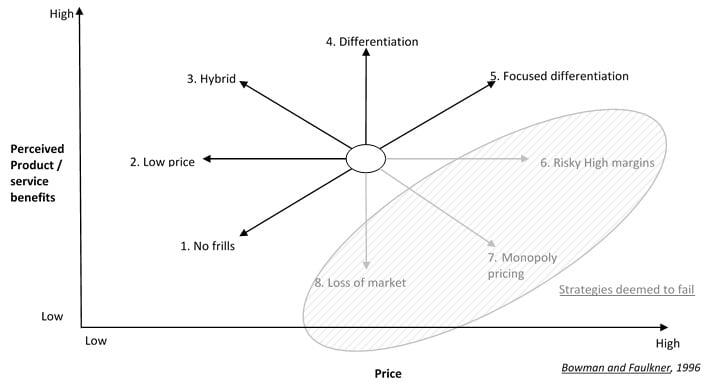Understand your "Product - Price perception"
Are you wondering how your product is or should be positioned based on its price and perceived value? How it compares with similar types or products on the market? Or even what potential change in product strategy should be applied to gain additional market share?
Product/Service positioning plays a key role in the long-term success of a business. The placing decision is both a strategic and marketing choice, which will allow the business to grow and customers to relate to the product/service in a certain way.
Management needs to understand the eight fundamental strategic options below, to ensure optimal decision making and to improve its competitive position in the market.
The different positioning strategies within a marketplace are based on both perceived benefits and price, as presented below:

Inspired from Porter’s generic competitive strategies, Bowman and Faulkner developed the above two-dimensional eight strategy clock, to help entrepreneurs and businesses identify their unique positioning, competitive advantage and to make necessary changes if needed.
1. No frills
Low price – Low perceived benefits. The only selling point in this strategy is the low price. High volumes of sales are needed. Your customers do not see any value added when using your product/service except from its price point.
E.g.: Daiso
2. Low Price
Low price – Some perceived benefits. This strategy relies on cost minimization and economies of scale to become the cheaper option of a decent product. High volumes of sales are also needed but can generate high profits in certain cases.
E.g.: EasyJet
3. Hybrid
Low price – High perceived benefits. The product/services selling point is product differentiation at a competitive price. The customer sees great added value despite the low prices.
E.g.: Quechua (Decathlon)
4. Differentiation
Average price – High perceived benefits. This strategy’s selling point is differentiation. The focus is on offering a product that diverges from the norm, without focusing on being the cost leader, as customers view these specific products as affordable high quality products.
E.g.: Starbucks
5. Focused differentiation
High price – High perceived benefits. Luxury and high quality products/services in nature, the focused differentiation strategy is based on high quality products, offered to a very selective customer base, with limited number of direct competitors’ offering similar products, which allows prices to remain high.
E.g.: McLaren
Strategies deemed to fail
6. Risky High margins
High price – Some perceived benefits. Customers’ do not perceive sufficient benefits to justify the high prices charged, and will ultimately look for better quality products.
7. Monopoly pricing
High price – Low perceived benefits. Companies in this position are usually the only ones offering a certain type of product/service and customers only choice is to buy or not. The customer is dependent on the product/services the monopolist offers and it is important that regulations are put into place.
E.g.: Microsoft (1990s), Microsoft demanded software developers exaggerated prices for the patent license. As a result, Microsoft was fined $1.3 Billion by the EU due to antitrust laws.
8. Loss of market share
Average price – Low perceived benefits. The company charges a middle-of-the-range price for a product/service that customers see to provide little to no benefits to them. This is not a good position to be as a business.
E.g.: Blackberry
The Bowman’s clock is one of the possible ways to understand your product positioning.
BYRD Consulting will guide or accompany you in developing the best suited strategy for your business.